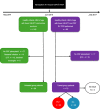Impact of rapid enterovirus polymerase chain reaction testing on management of febrile young infants < 90 days of age with aseptic meningitis
- PMID: 32299396
- PMCID: PMC7161008
- DOI: 10.1186/s12887-020-02066-0
Impact of rapid enterovirus polymerase chain reaction testing on management of febrile young infants < 90 days of age with aseptic meningitis
Abstract
Background: Diagnostic evaluation of febrile young infants is challenging. Empirical antimicrobial treatment is therefore common practice in this setting despite high percentage of causative viral infections. The objective of this study was to investigate the impact of rapid enterovirus cerebrospinal fluid polymerase chain reaction (CSF EV PCR) test on hospital length of stay (LOS) and antimicrobial treatment duration in young febrile infants.
Methods: Retrospective observational study comparing duration of antimicrobial treatment and hospital LOS before (May 1, 2014 - May 30, 2015, untested group) and after (June 1, 2015 - June 30, 2017, tested group) the introduction of rapid CSF EV PCR testing in infants < 90 days of age presenting with fever and CSF pleocytosis at the University Children's Hospital Zurich. Additionally, the same variables were compared after test introduction between CSF EV PCR positive and negative children.
Results: One hundred twenty-eight children were enrolled in the study, 58 before and 70 after the introduction of rapid CSF EV PCR testing. Duration of antimicrobial treatment was significantly shortened in EV positive (n = 42) compared to both EV negative (n = 28) (median 18 h and 48 h, respectively, p < 0.001) and untested patients (n = 58) (median 18 h and 48 h, respectively, p < 0.001), and also in tested compared to untested group patients (median 36 vs 48 h, p < 0.001). Hospital LOS was significantly shortened in EV positive compared to EV negative patients (median 3 days and 4 days respectively, p = 0.013), while an overall reduction was not observed between tested and untested group patients.
Conclusions: In this study we demonstrate that antimicrobial treatment duration could be significantly shortened in neonates and young infants < 90 days of age with aseptic meningitis after the introduction of a rapid CSF EV PCR test compared to untested patients before test introduction.
Keywords: Antibiotic treatment; Children; Fever; Pleocytosis; Sepsis.
Conflict of interest statement
The authors declare that they have no competing interests.
Figures



References
-
- Baker MD, Avner JR, Bell LM. Failure of infant observation scales in detecting serious illness in febrile, 4- to 8-week-old infants. Pediatrics. 1990;85(6):1040–1043. - PubMed
Publication types
MeSH terms
LinkOut - more resources
Full Text Sources

